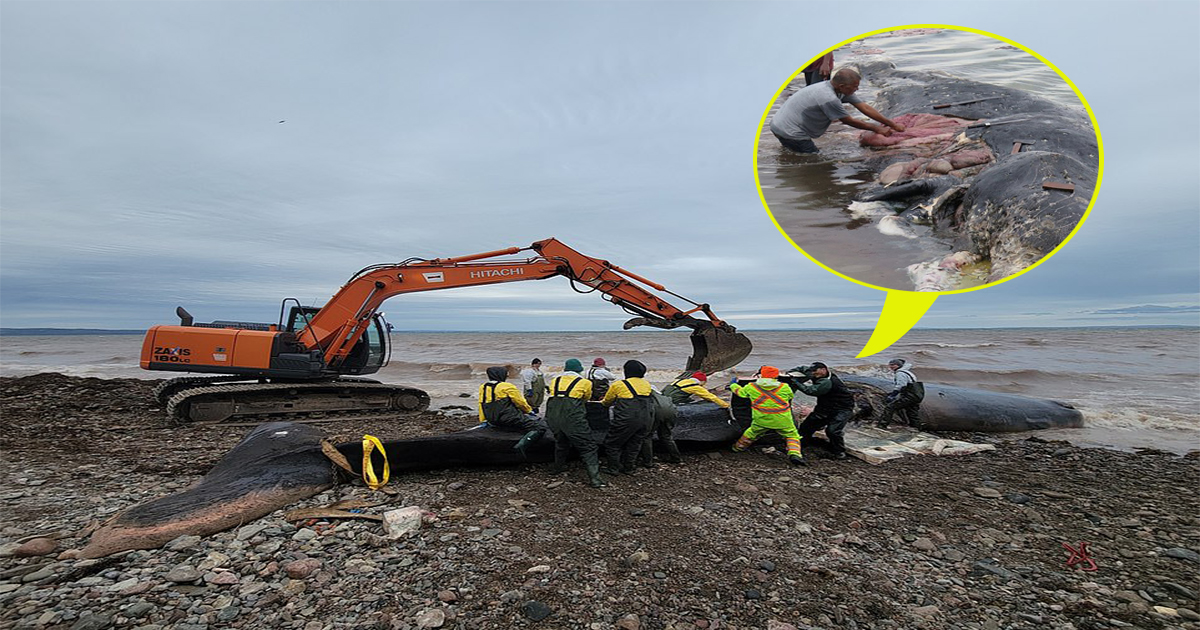More than 330 pounds of GARBAGE is found in the stomach of whale that died ‘a slow and painful death’ on the shores of Nova Scotia
More than 330 pounds of garbage was discovered in the stomach of a sperm whale that met a slow and painful death on the shores of Nova Scotia. The massive 45-foot-long whale appeared emaciated and weighed around 30 tons when it washed ashore on November 4. Despite efforts to rescue the whale, it succumbed to its fate the following day. An autopsy conducted by the Canadian Wildlife Health Cooperative revealed a shocking amount of trash in the whale’s stomach, including fishing nets, gloves, ropes, and various plastic items.
The incident has served as a stark reminder of the alarming problem of human-generated waste polluting the Earth’s oceans. The Marine Animal Response Society (MARS) emphasized the severity of this issue, calling attention to the dire consequences it can have on marine life.
The male sperm whale’s close encounter with the shore and its emaciated condition raised concerns among wildlife officials, leading them to suspect that its death was not a natural occurrence. Typically weighing between 35 to 45 tons, this fully grown whale weighed less than the average due to the obstruction caused by the ingested trash, which hindered its ability to eat.
Tonya Wimmer, representing MARS, expressed her concerns about the distressing signs observed in the thin and weakened sperm whale. The discovery of the extensive amount of garbage inside the whale’s stomach was described as horrific. Sperm whales, known to consume prey by opening their mouths and allowing anything in the vicinity to flow inside, are more susceptible to ingesting trash present in the water and on the seafloor.
While plastic ingestion by sperm whales is not uncommon due to their feeding behavior, the quantity compacted inside this male whale was unprecedented. The autopsy revealed a massive clump of trash weighing 330 pounds, obstructing the whale’s ability to consume food and ultimately leading to its starvation.
Wimmer noted that the slow demise of the whale must have been incredibly distressing and traumatic for the animal. Sadly, this incident is not isolated, as numerous sperm whales have been found with plastic waste in their stomachs. Examples include a whale discovered in Northumberland in 2019 and another in eastern Indonesia in 2018, which contained a 13-pound lump of plastic waste.
Recent studies have highlighted the alarming ingestion of microplastics by baleen whales, such as blue, humpback, and fin whales. These large filter feeders, consuming prey like krill, can consume up to 10 million pieces of microplastic every day. Baleen whales, particularly blue whales, are more vulnerable to plastic ingestion due to their position in the food chain and their filter-feeding behaviors. They play a crucial role in highlighting the environmental impact of pollution, including microplastics.
Understanding the daily plastic consumption of baleen whales and its potential risks and health effects is crucial for mitigating the impacts of pollution. The study’s senior author, Jeremy Goldbogen, emphasized the importance of large filter feeders like baleen whales as sentinels of environmental change, including the presence of microplastics. Their ability to process vast amounts of ocean water makes them valuable indicators of pollution levels and the need for effective solutions.
The heartbreaking incident involving the whale in Nova Scotia serves as a powerful reminder that urgent action is required to tackle the problem of ocean pollution caused by human-generated waste. Efforts should focus on reducing plastic waste, improving waste management systems, and promoting awareness to protect marine ecosystems and the magnificent creatures that inhabit them.
Hits: 1











